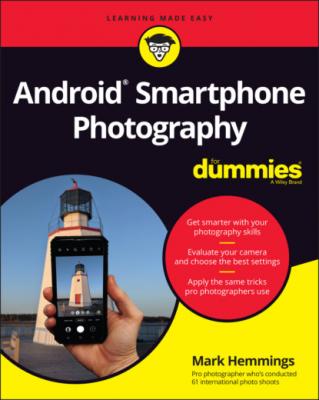ТОП просматриваемых книг сайта:
Android Smartphone Photography For Dummies. Mark Hemmings
Читать онлайн.Название Android Smartphone Photography For Dummies
Год выпуска 0
isbn 9781119824923
Автор произведения Mark Hemmings
Жанр Программы
Издательство John Wiley & Sons Limited
So to start you out on a path to photographic success, I assume that you
Have an Android smartphone and its operating system is up to date.
You have access to Wi-Fi or use a data plan with your mobile phone provider.
Other than these two presumptions, I explain everything else in the book in great detail so that you never feel overwhelmed or bogged down.
Icons Used in This Book
This book, like all For Dummies books, uses icons to highlight certain paragraphs and to alert you to particularly useful information. Here’s a rundown of what those icons mean:
Beyond the Book
In addition to what you’re reading right now, this product also comes with a free access-anywhere Cheat Sheet. To get this Cheat Sheet, simply go to www.dummies.com and search for “Android Smartphone Photography For Dummies Cheat Sheet” in the Search box.
Where to Go from Here
Throughout this process of discovering the ins and outs of Android smartphone photography, take inspiration from other photographers who have mastered their preferred photographic genre. Instagram is a good resource for this. However, it’s critical that you don’t allow yourself to feel bad if your photos are not up to that level. Practice creating photographs every day, if possible, and you will most certainly see your abilities improve radically over a short period of time.
Creativity is in everyone to some degree, and it’s often the case that we simply need a guide to kick-start that engine. It’s my hope that this book will serve that function and help you to master the technical parts, which will free you to absorb the artistic aspects of smartphone photography. I know that you can do it!
Part 1
Using Your Camera Straight out of the Box
IN THIS PART …
Get an introduction to Android smartphone photography.
Take an Android camera tour.
Set up your Android camera for best results.
Take a deep dive into the Camera app.
Chapter 1
Introducing Android Smartphone Photography
IN THIS CHAPTER
Whether you’re brand new to photography using a smartphone, or new to the Android operating system, the aim of this chapter is to familiarize you with the basics so you can get out and start photographing as soon as possible. It’s such an incredible feeling to have a powerful camera always with you, in your pocket, bag, or purse. After reading through this introduction to Android cameras, you should feel confident creating images with a smartphone. The photo opportunities await, so get excited about your Android smartphone and its surprisingly high-quality cameras!
Becoming Familiar with Your Android Camera
In the fantastic world of Android-powered mobile devices, you find a wide assortment of lens combinations. Each manufacturer of Android-based smartphones offer a single camera (often with a slightly wide-angle view), and the majority offer what is called a multi-lens combo. It’s common these days to see Android smartphones with three cameras plus a front-facing selfie camera.
The following list explains a rough description of the most common Android smartphone lens combinations. Some smartphones have one lens, some two, some three, and a few have four or more lenses. Multi-lens smartphone camera lenses are usually described as
Ultra-wide: Made for sweeping landscapes or interior architecture.
Wide-angle: This is usually the default general-use lens for all smartphones.
Telephoto: More of a zoomed-in look, great for portraits and nature.
Super-telephoto: Very zoomed-in look, perfect for distant wildlife and even for capturing a full moon!
Single-lens models
When someone mentions that their smartphone has a single lens, they’re usually referring to what’s called the rear, or back-facing lens, not the selfie lens that faces you and allows you to take a photo of yourself (more on selfies in Chapter 2). If your smartphone only has one lens, which is usually called a wide-angle lens, don’t feel left out! Most of the great documentary, photojournalism, and street photographers of the past and present have created their best work with a single wide-angle lens. You can do the same.
Figure 1-1 shows off the small but powerful single

